 |
down the border with the Republic of South Africa (photo S. Renner).
Back to the previous page
|
Claudio Martinez from Argentina (see his prediction site) , discovered in October 2002 two important stellar occultations by Titan, involving the bright Tycho stars 1343-1615-1 (V= 8.6) and 1343-1865-1 (V= 10.7).
These two events fortuitously occurred on the same day, 14 November 2003, and were separated in time by only 7 hours. They occurred more than 14 years after the famous 28 Sgr (V= 5.5) occultation of 3 July 1989, observed from the Middle East and Europe. Only in December 2001 could another occultation of a fainter double star be observed from northern America and Pacific Ocean.
The two November 2003 occultations thus provided the last opportunity to probe with high spatial resolution Titan's stratosphere before the entry of the Huygens probe in January 2005, see below.
The scientific context of the November events, with plannings, updated predictions, visibility maps, photometric information, etc... can be found in Bruno Sicardy's site (Paris Observatory), with complementary information in Leslie A. Young's site (Southwest Research Institute in Boulder, USA) and the IOTA site, partly maintained by Wolfgang Beisker (European Section, Germany).
These sites allowed many of the people involved in these observations to clearly announce their plans and to coordinate their efforts in advance.
This page summarizes the preliminary results obtained by the Paris Observatory group and collaborators. We acknowledge partial supports by the Conseil Scientifique de l'Observatoire de Paris, by the Programme National de Planétologie (CNRS/INSU) and by the European Space Agency. The local organizations benefited from the unvaluable helps of Ian Glass, Cliff Turk and Peter Schönau in South Africa and Sonja Enke in Namibia. We also thank the personnels of the French Ambassy in Namibia and the French Consulate in Cape Town for their warm welcome and helpul advice.
The organization of the expeditions in Paris was made possible thanks to the energy and daily help from Jacqueline Thouvay (LESIA).
 |
The strategy was to use fixed observatories as well as portable stations, in order to maximize the chances of good weather and of detecting the central flash.
Furthermore, portable stations were set up in La Réunion, western South Africa, central and southern Namibia, as shown in the diagrams below. (The names in parentheses indicate the sites where clouds or technical problems prevented the gathering of data).
The diagrams in the left column show the paths of Titan's shadow on the Earth (light grey), i.e. the regions where the occultation was observable. The darker central regions in this left column show where the the central flash was in principle visible. The other diagrams are zoomed in versions, with the central flash region in light grey. Each dot marks the center of the shadow at one minute intervals. Note that these paths correspond to the predictions before the occultations, see the previous page, and may not correspond to reality. Updated paths will be drawn when avalaible.
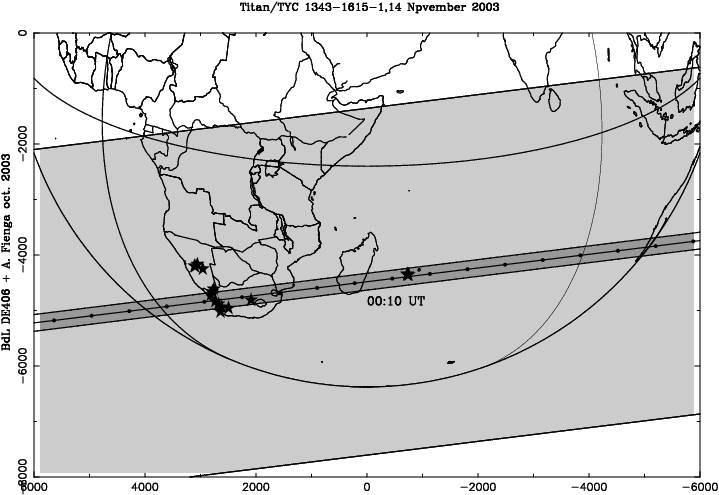 |
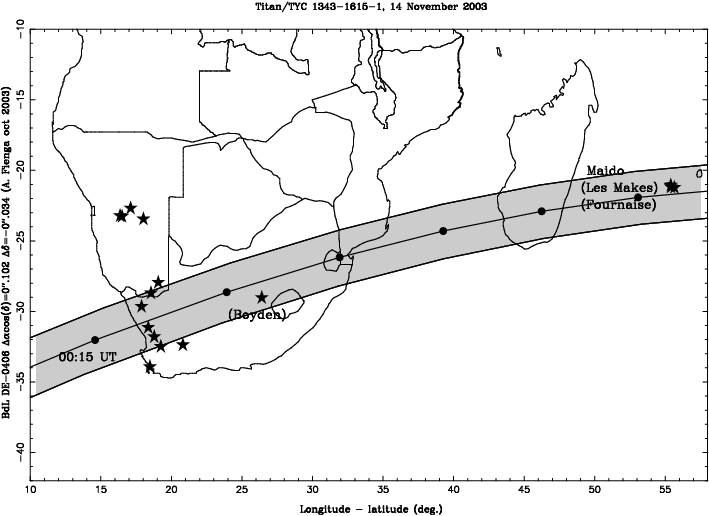 |
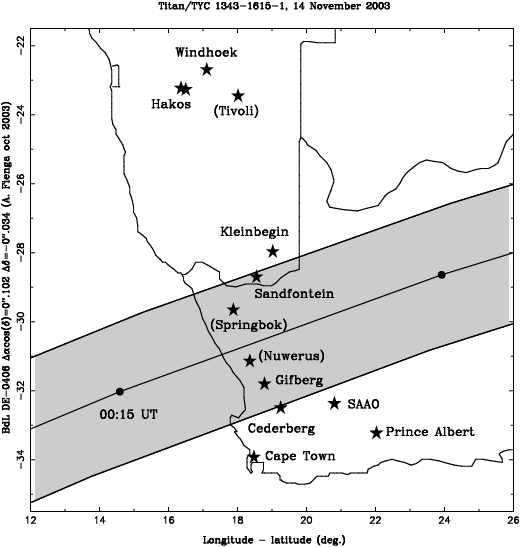 |
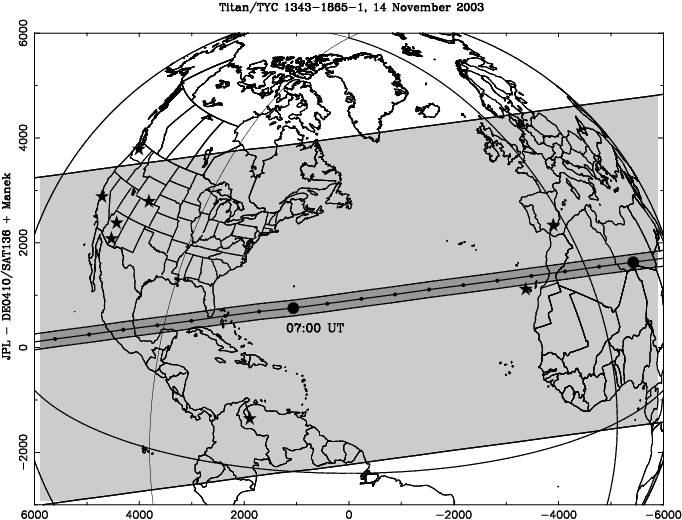 |
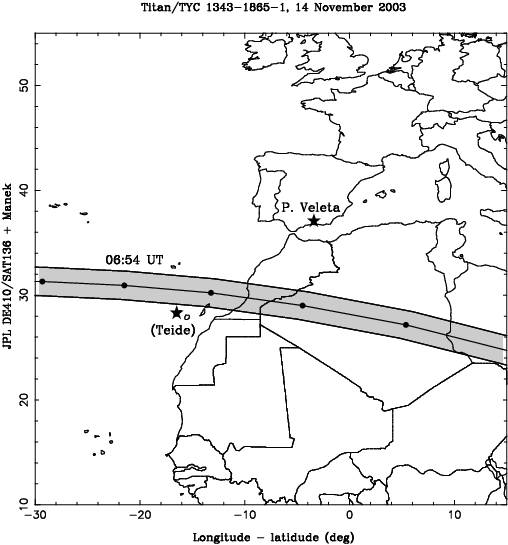 |
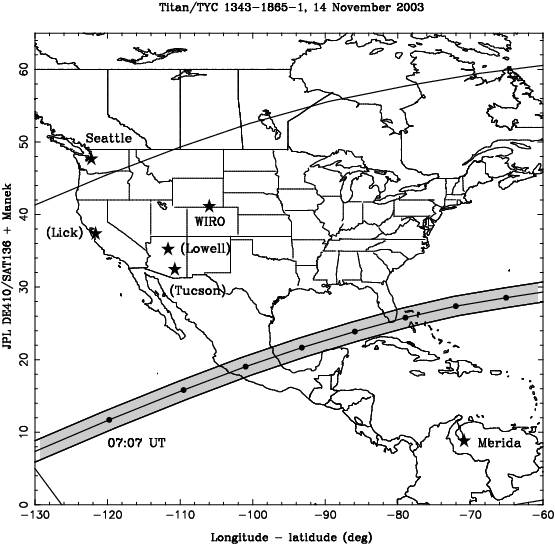 |
SAAO: the following light curve was obtained by Ian Glass (SAAO) and Francesca Ferri (Univ. of Padova), using a fast photometer attached to the 1-m telescope at the SAAO Sutherland Observatory (I band, 0.9 microns). The sampling time interval is 0.1 sec. The altitude range probed by the star is about 500 km above Titan's surface at the beginning of the occultation, down to about 250 km for the deepest layers, corresponding to the central flash.
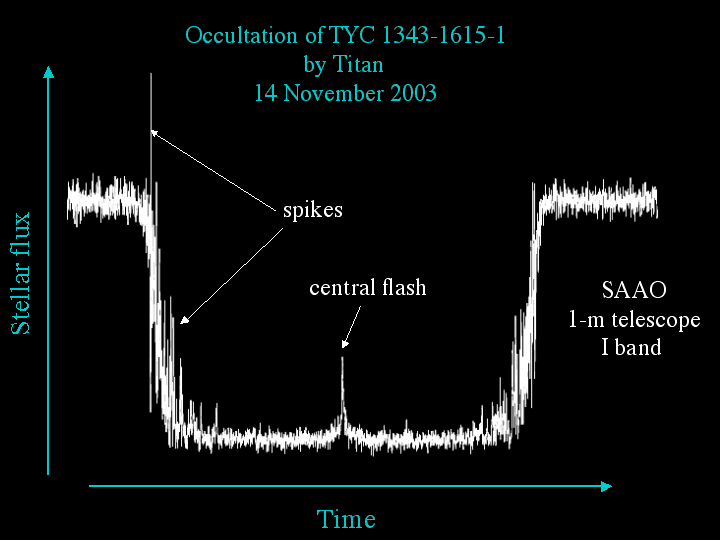 |
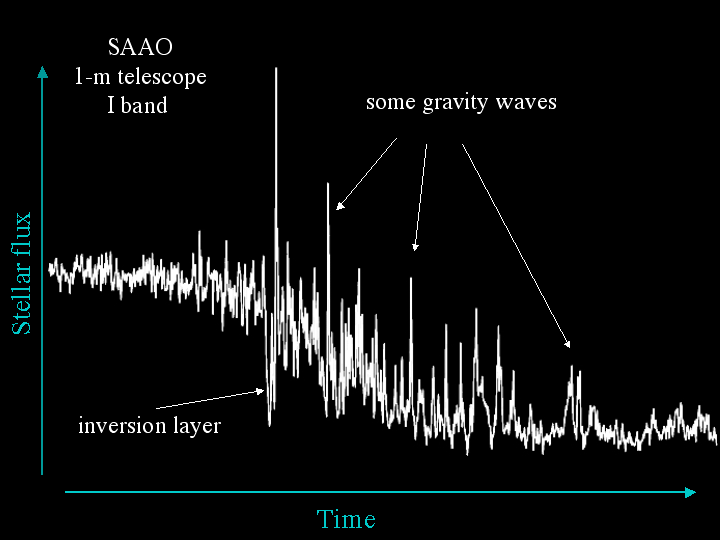 |
Note the presence of the central flash, due to the focusing of light near the center of the shadow. It is caused by the atmospheric layer at about 250 km altitude in Titan's stratosphere (or a pressure level of ~ 0.25 mbar).
The flash was also observed at the nearby 1.4-m IRSF japanese telescope. The following light curve has been derived by Daisuke Baba and Tetsuya Nagata, using the IR camera in the K band (2.2 microns). Note the clear difference between the central flashes in the I and K bands. This strong chromatic effect may caused in part by the presence of aerosols at that atmospheric level.
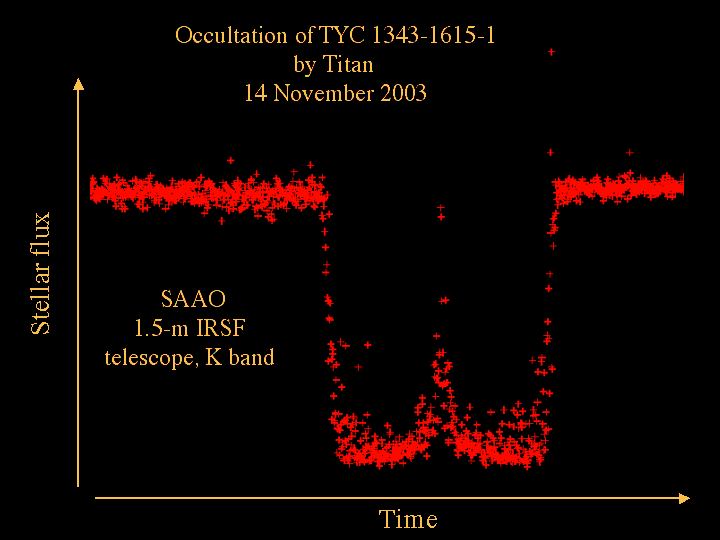 |
More detections of the central flash were made in other stations in South Africa. See for instance below the light curve obtained by Wolfgang Beisker with a 30-cm portable telescope at the Cederberg station, using a IOTA camera and a 700-900 red filter.
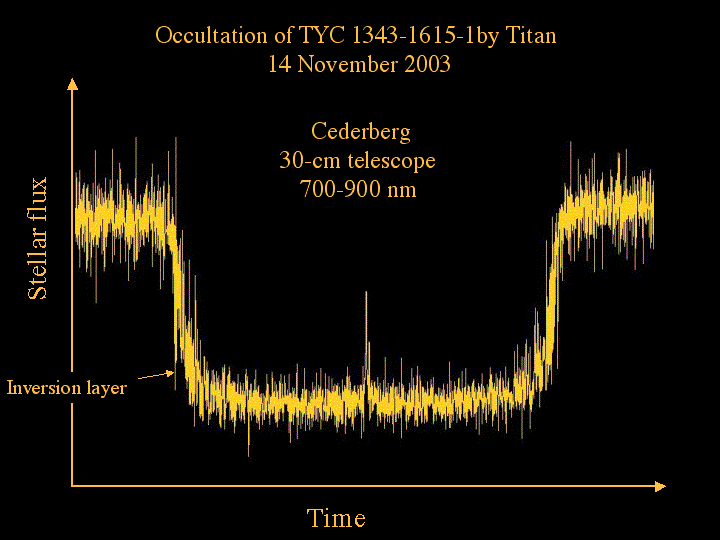 |
Also noteworthy is the strong stellar scintillation et ingress and egress, see for instance the high spikes in the SAAO 1-m immersion light curve shown above. These spikes are thought to be associated with an active field of breaking gravity waves at that level of Titan's atmosphere, i.e. at typical altitudes 300-500 km, or pressures 1-100 microbars, (see Sicardy et al., Icarus , ???, 1999).
Note finally the conspicuous dip (labelled "inversion layer" in some of the figures above). Such dips were also observed during the 28 Sgr occultation in 1989, at about the same altitude in Titan's atmosphere. They are caused by "inversion layers", corresponding to sudden temperature increases (up to 10-20 Kelvin) over small altitude ranges (5-10 kilometers).
Because the star TYC 1343-1615-1 has an angular diameter about 10 times smaller than 28 Sgr, the spatial resolution in Titan's atmosphere is very much improved with respect to the 1989 occultation. This resolution reaches roughly one kilometer at the level of the dip ( vs. about ten kilometers for the 1989 event).
These local density fluctuations may be of great importance during the entry of the Huygens probe in January 2005. As the aerodynamical braking of the atmosphere proceeds, the probe will be subjected to strong fluctuations of acceleration, associated with these density fluctuations (very much like in the well known "zones of turbulence" announced by the airplanes captains). This could be a hazard for the probe, as the only way that the spacecraft must rely on to know where it is, and thus decide what to do (open the parachute, release the thermal shield, etc...) is to use the data from the accelerometer.
Thus, the data obtained during the November 2003 stellar occultations will help gathering information on Titan's atmospheric fluctuations in the 250-500 km altitude range, and thus help better address the possible hazards associated with these fluctuations.
 |
|